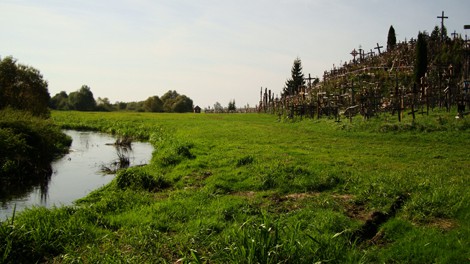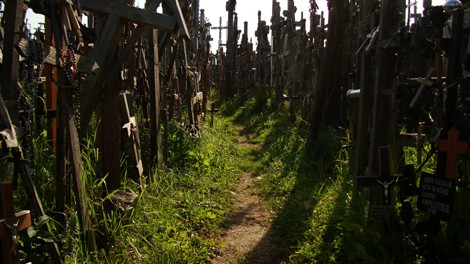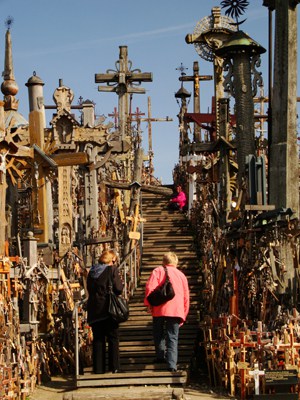

My Lonely Planet guide cites the hotel and adds that it has been renovated, which explains why the exterior and interior look very proper. Though renovated, the soviet spirit still remains: the room they gave me was comfortable yet tight, austere and very functional; the furniture is very much outdated and the walls of the hotel are painted in a dull color – something between orange and mustard; at breakfast a hotel staff chases everyone and demands they show their 'breakfast ticket!’
Siaulai offers some interesting and random cultural sights, such as: the bicycle museum, the radio & TV museum, churches, cathedrals and more. It has one main pedestrian drag – Vilniaus Street – lined with shops, cafes, bars and clubs. If not fot this popular lane, then the city would be nothing more than a collection of stiff and rusted out Soviet-era buildings. But by far the most interesting sight in Saulai is the mystical Hill of Crossses.
This sight lies about 12 km from the city and is self-explanatory – it is simply a hill covered with crosses – but it is its significance and how that significance changed over time that enchants.

Although it is not known exactly when the practice of planting crosses on the hill first started and why on that particular hill, it is believed that Lithuanians started out of religious reasons sometime during the 18th century. The political climate then changed: in the late 18th century Lithuania became part of the Russian empire. Lithuanians then started putting up crosses on the hill in remembrance of the rebels who lost their lives fighting for independence.

Independence was won then lost to the Germans first during WWII then to the USSR in 1944. During Soviet occupation, from 1944-1990, Lithuanians planted crosses on the hill as a sign of their national identity and their protest against soviet occupation. Interestingly, the soviets, wanting to strike a psychological blow against Lithuanians, bulldozed the hill, but Lithuanians returned and planted even more crosses.
The day I went to the Hill of Crosses was unusually warm for the month of September – almost like a summer day. Rather than take the bus I rented a bike from the tourist information office and cycled all the way. Though the bicycle lane is not always clearly indicated, riding on the sidewalk was easy enough and got easier once I left the city behind.

After about 45 minutes of cycling up and down hills, past large green fields and rows upon rows of tall trees, and after ingesting a few of those small insects that have nothing better to do but hover in the air on your cycling path, I finally made it to the sight. It was hidden away from the main street, in a peaceful spot near a winding river and near a thicket of trees. The sky was a clear blue, a gentle breeze blew and the soft chime of metal crosses rang everywhere the air.

Note from the Editor:
Mohamed Asem is a writer from Kuwait and currently on a journey across eastern/central Europe.
His articles from the journey: Crossing the Polish-Czech Border on Foot
Part 1 of 4
https://polishnews.com/index.php?option=com_content&view=article&id=2001:crossing-the-polish-czech-border-on-foot-&catid=87:podroetravel&Itemid=305
